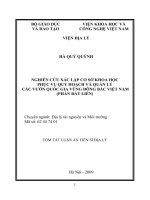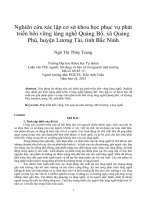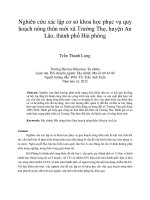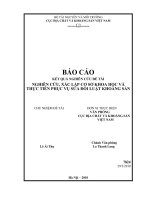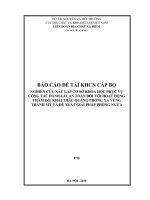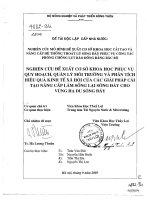Nghiên cứu xây dựng cơ sở khoa học về phân vùng chất lượng nước sông theo mục đích sử dụng ứng dụng cho sông nhuệ sông đáy tt tiếng anh
Bạn đang xem bản rút gọn của tài liệu. Xem và tải ngay bản đầy đủ của tài liệu tại đây (1.12 MB, 27 trang )
MINISTRY OF NATURAL RESOURCES AND ENVIRONMENT
VIETNAM INSTITUTE OF METEOROLOGY,
HYDROLOGY AND CLIMATE CHANGE
CAI ANH TU
RESEARCH ON DEVELOPING A SCIENTIFIC BASIS FOR
ZONING RIVER WATER QUALITY ACCORDING TO USE
PURPOSES - APPLY FOR NHUE RIVER - DAY RIVER
Major: Natural Resources and Environment management
Code: 9850101
SUMMARY OF THE DISSERTATION
NATURAL RESOURCES AND ENVIRONMENT
MANAGEMENT
Ha Noi, 2020
The dissertation was completed at:
Viet Nam Institute of Meteorology, Hydrology and Climate
Change
Supervisors:
1. Assoc. Prof. Dr. Duong Hong Son - WRI
2. Dr. Le Ngoc Cau - IMHEN
Reviewer 1:………………………………………..
Reviewer 2:………………………………………..
Reviewer 3:………………………………………..
The dissertation shall be defended in front of the dissertation
Committee at Viet Nam Institute of Meteorology, Hydrology and
Climate Change
At..…hour, date..…/..…/2020
The dissertation can be found at:
- Vietnam National Library
- Library of Viet Nam Institute of Meteorology, Hydrology and
Climate Change
1
INTRODUCTION
1. The necessity of the dissertation:
Effective activities that are often used to manage water
pollution are control of waste sources, planning of drainage and
wastewater treatment systems, planning of water resources, etc.
The above action should be based on the results of zoning of
water quality according to use purposes or in other words,
zoning of river water quality (RWQ) according to use purposes
(UPS) contributes to the effective implementation of the water
environment management and protection activities.
However, at present, the zoning of RWQ according to UPS
has not been implemented comprehensively and systematically,
based on a scientific and practical basis. This is partly reflected
in the judgment made in the report "National environmental
status, 2018" as "An important basis for implementing water
protection in river basins is to determine the use purpose of the
water source, which is still open.”[7]. The zoning has not been
agreed in the same river basin as well as between river basins
across the country, that making it difficult for water resources
management activities in river basins. From the reason and
practice
mentioned above,
the author
implements
the
dissertation "Research on developing a scientific basis for
zoning river water quality according to use purposes – Apply
for Nhue river – Day river”
2. Research objectives and research contents
- Research objectives
2
+ To identify and clarify the scientific basis for
implementing the zoning of RWQ according to UPS.
+ To propose criteria, process, and content of the
implementation of zoning of RWQ according to UPS.
+ To study and apply the process for zoning RWQ according
to UPS for Nhue and Day rivers.
- Research contents
To achieve the above objectives, the dissertation deals with
the following contents:
+ Overview of studies on the scientific basis for zoning
RWQ according to UPS of some countries in the world and
Vietnam, and overview of studies on water quality (WQ) in
Nhue and Day rivers.
+ To approach and build the scientific basis for the zoning of
RWQ according to UPS.
+ To apply and adjust the scientific basis for the zoning of
RWQ according to UPS into practice (for Nhue and Day rivers).
3. Research subject and research scope
- Research subject: The scientific basis for the zoning of
RWQ according to UPS is applied to all rivers.
- Research scope: For all rivers (the scope of the dissertation
is Nhue and Day rivers).
4. Approach to the scientific basis for zoning WQ according
to UPS.
The approach to the study of the dissertation includes
synthetic; systematic and ecological management.
3
5. The scientific and practical significance of the dissertation
- Scientific significance: The dissertation determined and
clarified the methodology and research methods for zoning
RWQ according to UPS such as:
+ The zoning of WQ according to UPS is defined as a form
of the environmental functional zoning with unit "region"
corresponding to river and "sub-region" corresponding to river
sections.
+ Assessing the WQ in the zoning of WQ according to UPS
is not merely based on the comparison of the results of WQ
monitoring with QCVN 08-MT:2015/BTNMT (National
technical regulation on surface WQ) and WQI (Water Quality
Index) but also need to be associated with the specific
characteristics of internal and external factors in the river/river
section as well as linked with tools of the indicators (WQIaq,
WQIhi, DRo) to assess.
+ The process of implementing the zoning of RWQ
according to UPS was proposed by the dissertation based on
consideration and evaluation of 19 criteria belonging to three
groups of natural, social, and environmental characteristics. The
criteria were proposed to meet scientific requirements, practical
conditions, and feasibility with the condition of managing
surface water resources of Vietnam.
- Practical significance: The research results of the
dissertation are useful documents for surface water resources
management, including the development of environmental
4
protection planning, socio-economic development planning,
water resources planning, water drainage, and water treatment
planning. The document also provides support for more
effective implementation of other environmental management
activities related to environmental protection of river water.
6. New contributions of the dissertation
- Developed a set of criteria for zoning RWQ according to
UPS belonging to 3 groups of natural, social, and environmental
characteristics.
- The process and contents of implementing the zoning of
RWQ according to UPS have been developed and successfully
applied to Nhue and Day rivers.
7. Structure of the dissertation
In addition to the introduction and conclusion, the
dissertation consists of four chapters.
Chapter 1: Overview of studies related to the scientific
basis and implementation for zoning RWQ according to UPS
Chapter 2: Object, scope, and research method
Chapter 3: Developing the scientific basis for zoning of
RWQ according to UPS
Chapter 4: Applying the scientific basis for zoning of RWQ
according to UPS for Nhue, Day rivers
5
CHAPTER 1. OVERVIEW OF STUDIES RELATED TO
THE SCIENTIFIC BASIS AND IMPLEMENTATION
FOR THE ZONING OF RIVER WATER QUALITY
ACCORDING TO USE PURPOSES
1.1. Overview of studies related to the scientific basis for the
zoning of river water quality according to use purposes
1.1.1. Overview of studies related to the scientific basis for
the zoning of river water quality according to use
purposes of some countries in the world
Australia [79], [82], [97]: Australia (2000 and 2005) issued
a national action plan on WQ and the purposes of WQ.
Determining the purposes of WQ was divided into 2 phases
with 10 steps of implementation.
Federal Republic of Germany [89], [90]: Guidelines for
defining the purposes of WQ for river sections based on the
results of monitoring 18 parameters in the classification system
(Elbe, Rhine, and Danube rivers).
United States [88]: The scientific basis
for the zoning of RWQ according to UPS is given by
considering the factors of natural and
socio-economic characteristics.
Japan
[75]:
Standards
of
water
environment quality are stipulated in the
Law
on
Water
Pollution
Control.
In
particular,
WQ
standards
include
37
parameters.
6
World Health Organization (WHO) [107]: WHO issued
guidelines for the protection of the recreational environment
(2003). The guidelines only focus on protecting the
entertainment environment, while there are many other
purposes of water sources that need attention that has not been
mentioned by WHO.
1.1.2. Overview of studies related to the scientific basis for
zoning river water quality according to use purposes in Viet
Nam
- Le Trinh et al. (2008) [58]; Pham The Quang, Duong Hong
Son et al. (2010) [33]; Department of Natural Resources and
Environment of Thai Nguyen (2011) [37]; Center for
Environmental Monitoring (2012 and 2016) [43], [62].
From the overview of the related studies, the dissertation
found that the main issues that are still open about the contents
related to the scientific basis and the process of zoning WQ
according to UPS. These issues have not yet been implemented
in a uniform, systematic way. So there are some major
limitations as follows:
+ The approach of most studies focuses on using results of
monitoring WQ to assess the ability to receive wastewater from
the water source and have not gone into depth to consider the
synthesis of internal and external factors affecting WQ
according to UPS.
+ Results of zoning WQ for river sections in the study area
have not shown the relationship with the use purposes of the
water source.
7
1.2. Overview of studies on the water quality and current
status of water use of Nhue river and Day river
1.2.1. Studies on the water quality of Nhue river and Day river
Le Vu Viet Phong, Tran Hong Thai (2006) [32]; Department
of Water Resources Management (2007) [17]; Nguyen Van Cu
et al. (2004-2009) [18]; Dang Dinh Duc (2009) [21];
Department of Waste Management and Environmental
Improvement (2009) [19]; Van Thi Hang (2010) [24]; Trinh
Minh Ngoc et al. (2013) [31]; Le Hung (2012) [27]; Committee
for environmental protection of Nhue-Day river basin (20132014) [70]; Nguyen Toan Thang (2016) [54]. From the results
of studies on WQ of Nhue river, Day river showed that:
Studies based on QCVN 08-MT: 2008/BTNMT (now
QCVN 08-MT: 2015/BTNMT) to analyze, compare and
evaluate with each environmental parameter and apply the tools
such as WQI, QUAL2E model, MIKE 11 model to solve
research problems.
- The WQ of Day river is better than Nhue river (The WQ of
Nhue river is heavily polluted, The WQ of Day river is mainly
polluted locally in some areas passing residential areas,
industrial parks, where receiving large sources of waste).
1.2.2. Studies on the current status of water use of Nhue
river and Day river
In Nam Dinh Water Resources Planning Report (2017) [73];
Ninh Binh Water Resources Planning Report (2017) [74];
Center for Environmental Monitoring, Vietnam Environment
Administration (2016) [62]. Result of studies on the current
status of water use of Nhue river and Day river showed that:
8
- On Day river, most of the river water is used for 2 purposes
or more (using water for daily life, irrigation, aquaculture).
- Comparing with the water use of Nhue river, Day river
water is used for many purposes. Even many river sections in
Ha Nam and Ninh Binh province, water river is used for
domestic purposes.
CONCLUSION OF CHAPTER 1
Chapter 1 of the dissertation reviewed the studies related to
the scientific basis for zoning RWQ according to UPS in the
world and Vietnam. From that, drawing on international
experiences and practical situation in Vietnam to clarify gaps in
this study.
To contribute to perfecting the scientific basis for zoning
RWQ according to UPS in Vietnam, the dissertation proposes
an approach, method, and content of implementation to
overcome the above-mentioned issues. The research diagram of
the dissertation is shown in Figure 1.5.
Identify the approach
Select methods/tools to
implement for the zoning
of RWQ according to
Determine a set of
criteria for the zoning
of RWQ according to
UPS
Develop the process of
12 steps with
implementation contents
Develop the
scientific basis for
zoning RWQ
according to UPS
Apply the zoning of
RWQ according to
UPS for Nhue river,
Day river
9
Figure 1.5. Research diagram of the dissertation
CHAPTER 2. OBJECT, SCOPE, AND
RESEARCH METHODS
2.1. Research object and scope
Table 2.1. Research object and scope
Scope
Object
Develop the scientific basis and
process for zoing RWQ according to
All rivers
UPS
Nhue river and Day Apply the process to zone water river
sections
river
2.2. Research methods
2.2.1. Method of data collection and synthesis
The method is used to collect, synthesize, and analyze
relevant information such as natural conditions and socioeconomic of the study areas, legal documents on protection and
management of surface water, ...
2.2.2. Methods of Field survey, sampling, analyzing water
samples in the laboratory
The monitoring method is implemented under Circular No.
29/2011/MONRE dated August 1, 2011.
- Inheriting results of the analysis of WQ of Nhue river and
Day river from Center of Environmental Monitoring, General
Department of Environment (period of 2010 - 2014) [43].
The dissertation monitored 126 samples (72 water samples of
Nhue river and Day river in 2019 to compare WQ with the
period of 2010 - 2014 and 54 water samples of Nhue river and
10
Day river from 2015 to 2016 to assess the self-cleaning capacity
of a river).
2.2.3. Methods/tools indicators to assess water quality
The dissertation proposed and applied the following tools to
evaluate WQ in the WQ zoning.
(i) Method/Tool for assessing WQ according to QCVN 08MT: 2015/BTNMT [6].
(ii) A tool to evaluate WQ based on the WQI [45], [46].
(iii) Methods for assessing WQ based on the "river health
index” (WQIaq, WQIhi, DRo) proposed by the Mekong
association (2011) [84], [89]], [91], [93].
2.2.4. Method for calculating the demand for using water
according to coefficient/norms
This method relies on water supply coefficients/norms for
each water user in which data sources are collected reliably [9],
[10], [56], [57], [80], [95].
2.2.5. Method of estimating pollution amount and load
To estimate the amount and load of pollutant discharged
from waste sources in Nhue - Day river basin, the dissertation
used the quick identification method that Vietnam is still
applying [94], [95], [103].
2.2.6. Expert and Delphi method
Expert method: Collect the opinion of 30 experts to select
criteria and level/class for each criterion.
Delphi method: implemented to support the group discussion
process to quantify the selection, classification of criteria, and
11
to rank the zoning of RWQ according to UPS.
2.2.7. Modeling method
The modeling method is used in the dissertation through the
WASP model tool [108] to calculate the self-cleaning capacity
in the river/river section.
CONCLUSION OF CHAPTER 2
Chapter 2 has clarified the issues related to the object, scope,
and research methods for implementing the zoning of RWQ
according to UPS:
The dissertation had been done based on synthesizing from
the main research methods as follows: Collecting, analyzing,
synthesizing and inheriting research materials; sampling,
analyzing water samples in the laboratory and field survey;
applying methods/tools of indicator to assess WQ; using Delphi
and expert methods; modeling method. The above methods
applied in the study were selected based on analysis and
evaluation following actual conditions in Vietnam.
12
CHAPTER 3. DEVELOPING THE SCIENTIFIC BASIS
FOR ZONING RIVER WATER QUALITY ACCORDING
TO USE PURPOSES
3.1. Relationship between the zoning of river water quality
according to use purposes and the environmental zoning in
environmental planning.
In environmental planning [52], [57] often divided into:
+ Four types of environmental zoning: Landscape zoning;
environmental functional zoning; quality status zoning; zoning
according to the use of purpose.
+ Zoning units: Region, sub-region, and area.
+ Four types of sub-regions: Sub-region for conservation
and protection; sub-region for developing priority towards
environmentally friendly; Sub-region for developing the level
of permission; Sub-region for rehabilitating.
During the study process, PhD candidate found:
• The zoning of RWQ according to UPS is a form of
environmental functional zoning.
• Proposed WQ characteristics of 4 sub-regions
• The zoning of WQ is a step of the zoning of RWQ
according to UPS.
The dissertation also proposed that the time to review the
zoning of RWQ according to UPS is 5 years/time.
3.2. Principles of the zoning of river water quality according
to use purposes
According to the general principle of environmental
13
planning, the zoning of RWQ according to UPS has the
following main principles: Relatively uniformity of the subregion, the zoning of RWQ according to UPS is integrated but
not entirely dependent on socio-economic development
planning and other types of planning involved; using a multicriteria assessment tool, can integrate many different indicators;
the WQ and zoning of RWQ according to UPS are closely
related to each other; The purposes of using water need to be
feasible and, effective, and in line with management
requirements.
3.3. Relationship between internal and external factors with
river water quality
1) The relationship between internal factors with river WQ
The main internal factors include Characteristics of internal
natural conditions of the river; self-cleaning capacity of the
river; Characteristics of river ecosystems.
2) The relationship between external factors with river WQ
The main external factors include Features of natural
conditions outside of the river; Socio-economic characteristics;
objectives and activities of environmental protection in a river
basin.
3.4. Selecting standards/regulations and parameters of the
water environment in the zoning of river water quality
according to use purposes
1) Choosing standards/regulations
2) Selecting water environment parameters
With the arguments detailed in the dissertation, based on
14
that, the parameters to be selected and applied calculation for
the four tools of indicator (WQI, WQIaq, WQIhi, and DRo)
include 12 parameters: Temperature, pH, TSS, TDS, DO,
BOD5, COD, NH4 +, PO43-, NO3-, Coliform, Fecal Coliform.
3.5. Proposing criteria and level/class for zoning river water
quality according to use purposes
1) Proposing criteria
Three bases for giving the criteria in zoning of RWQ
according to UPS are: Meet the scientific; suitable with actual
conditions; feasible.
For zoning RWQ according to UPS, the dissertation
proposed 3 groups with 9 criteria (specified in Table 3.1),
including Group of criteria on natural characteristics with 3
criteria; Group of criteria on social characteristics with 2
criteria; Group of environmental criteria with 4 criteria.
2) Proposing to classify the zoning of RWQ according to
UPS
≤ 13 points belong to Group 1 - Suitable for sub-areas with
good WQ according to use purposes (≤ 50% compared to the
total score).
> 13 - <19 points belong to group 2 - Suitable for sub-region
with medium WQ according to use purposes (about> 50% ->
70% compared to the total score).
≥ 19 points belong to group 3 - Suitable for sub-areas with bad
WQ according to use purposes (about> 70% of the total score).
3) Proposing an identification of point scale in the zoning
of RWQ according to UPS
The dissertation proposed criteria and their point scale in Table
3.2.
15
Table 3.2. Proposing criteria and their point scale
No
Criteria
Internal factors
1 Position of subregion
2
3
4
5
1
Point scale
2
Upstream/within the
protection area of the
water exploitation works
to supply water for daily
life (Circular
24/2016/BTNMT [50]).
Value of
- The river section is an
conservation and habitat of rare, precious
protection of the creatures, and has diverse
sub-region
ecosystems in estuaries
and mangroves.
Current status of A1 – A2
WQ
Expected future The quality Improved
WQ
Self-cleaning
High (> 1 higher than the
capacity
average of Self-cleaning
capacity)
External factors
6 Current demand
for water use (8)
7 Demand for
water use in the
future(*)
8 WQ after
receiving
confluence river
9 Drainage
planning and
wastewater
treatment system
WQ (A1 – A2)
A1 – A2
Middle stream
3
Downstream
Historic sites,
scenic spots are
near the river
< A2 – B1
< B1 - < B2
The quality
remains the same
Medium (≤ 0,8 1)
The quality
dropped
Low (< 0,8)
WQ (< A2 – B1) WQ (< B1
- < B2)
< A2 – B1
< B1 - < B2
The quality Improved
The quality does
not change much
The quality
dropped
> 70% of treated
wastewater meets the
effluent standards
> 50% - 70 %
< 50%
3.6. Proposing a process of zoning river water quality
according to use purposes
The proposed process with 12 steps to follow (Figure 3.4).
16
Step 1: Collecting information and data
Step 2: Conducting a river survey
Step 3: Determining the sub-region scope
Step 4: Assessing the current status and trends of water demand in the river
Step 5: Determining the current status and trends of wastewater in river basin
Step 6: Determining the current status and trends of river WQ
Step 7: Determining the value of conservation and protection in the river
Step 8: Determining self-cleaning capacity of river
Step 9: Determining the priority of using, and classifying the zoning of RWQ
according to UPS
Step 10: Proposing solutions to implement the zoning of RWQ according to UPS
Step 11: Getting comments on the result of the zoning of RWQ according to UPS
Step 12: Reviewing and correcting according to the comments
Figure 3.4. The process for zoning RWQ according to PUS
CONCLUSION OF CHAPTER 3
Chapter 3 had solved the objectives of the dissertation to
develop a scientific basis and process of the zoning of RWQ
according to UPS. In addition to the content and methodology
related, the study also provided the approach, criteria,
indicators, and parameters for assessing river WQ which are
also mentioned on a scientific basis. On that basis, the process
was proposed with 12 steps (Figure 3.4).
17
CHAPTER 4. APPLYING THE SCIENTIFIC BASIS FOR
ZONING RIVER WATER QUALITY ACCORDING TO
USE PURPOSES FOR NHUE RIVER, DAY RIVER
4.1. Some main characteristics of natural and socioeconomic conditions of the Nhue-Day river basin
The flow regime of Day River is not only influenced by
climatic factors (rainfall regime, …), the water regime of the
Red river but also depends on the tide regime in the Gulf of
Tonkin with the amplitude decreasing from the North to the
South. At Day estuary, the amplitude is only from 2.0 to 3.0 m,
etc. The tide also has a great influence on the drainage and
flood drainage capacity of the river [28]. At downstream of
Nhue - Day river basin with distributaries of Dao river, Nam
Dinh river, Ninh Co river and tributaries of Hoang Long river,
Vac river. The intertwined river networks of this region are
greatly influenced by tides, especially in the dry season. [25].
The average population density across the basin is nearly 1,000
people/km2, which is 3.6 times higher than the national average
(277 people/km2) [68].
4.2. Process of zoning river water quality according to use
purposes for Nhue river and Day river
Implementing the process of zoning RWQ according to UPS
with 12 steps. From there, it serves as a basis for ranking the WQ
zoning of Nhue river and Day river.
18
4.3. Results of classifying the water quality zoning of Nhue
river and Day river according to use purposes
Results are shown in Table 4.32, 4.33, and Figure 4.17.
From the results of classifying by groups in Table 4.32 can see:
- In Nhue river:
+ Three sub-regions of type for conserving and protecting (due
to having the categories of conservation and protection near the
river): N1 (Lien Mac - Phuc La), N2 (Phuc La – Chiec bridge) and
N3 (Chiec bridge – Cong Than)
+ One sub-region of type for developing sub-region with
permission level/Sub-region limited development: N4 (Cong Than
– Hong Phu bridge) is in group 3 (Suitable for sub-region with bad
WQ according to UPS) suitable to supply water for poor quality
requirements
From the results of ranking by groups in Table 4.33 can see:
- In Day river:
+
Three
sub-regions
of
developing priority towards
environmentally-friendly: D5 (Que bridge - Gian Khau bridge), D6
(Gian Khau bridge - Yen Tri) and Đ7 (Yen Tri - Thuong Kiem) are
in group 1 (Suitable for ranking sub-region with good WQ
according to UPS) suitable to supply water for good quality
requirements such as domestic water supply, conservation of
aquatic flora and fauna and other cultural values.
+ One sub-region of type for conservating and protecting is D8
(Thuong Kiem - Cua Day): The river section needs to be
19
concerned with managing the unique ecosystems due to its
position as estuaries and saline area.
+ Two sub-regions of type for restoration are D2 (Mai Linh Ba Tha bridge) and D3 (Ba Tha - Te Tieu bridge) (Characteristics
to note here are: The river section has poor WQ and negative
impact on human health and the ecosystem. The priority is to
restore WQ to a safe level) and one sub-region with permission
level/sub-region limited development is D4 (Te Tieu bridge - Que
bridge) all belong to group 3 (Suitable to divide into sub-region
with poor WQ according to UPS). It is important to note here: The
sub-region/river section in the position that affects the WQ for
supplying domestic water of sub-regions in the downstream, so if
further economic development than the present, there are risks to
the environment and the human health (Table 4.32, figure 4.17)
4.4. Commenting on the appropriateness between the results of
zoning of RWQ according to UPS with the socio-economic
development planning, and adjusting the scientific basis,
criteria, and process after applying to Nhue river, Day river.
4.4.1. Commenting on the appropriateness between the results
of zoning of RWQ according to UPS proposed by the
dissertation with the socio-economic development planning
Zoning of RWQ according to UPS proposed by the
dissertation is suitable basically to the current status and also to the
development planning of Ha Nam province as well as other
provinces in the Nhue and Day river basins.
20
4.4.2. Adjusting the scientific basis, criteria, and process of
zoning of RWQ according to UPS after applying to Nhue
river, Day river
After the application of the scientific basis of zoning RWQ
according to UPS to Nhue river and Day river, the dissertation has
made some adjustments to the scientific basis, the set of criteria,
the process as follow: Clarifying the basis for commenting on the
classification of zoning RWQ according to UPS belong to the
environmental functional planning; adding 3 principles in a total of
5 and adding 3 steps to Implement in the process.
21
Table 4.32. Classification and zoning WQ of Nhue river according to use purposes
River
Section
1
Position
1
x
2
3
Value of
conversation,
protection
1
2
3
x
x
x
x
x
2
3
4
Current
status of
WQ
1
2
Expected
WQ
3
x
x
x
x
x
1
2
x
x
x
x
3
Current demand for
status of using water
demand for
in the
using water
future
1 2 3 1 2 3
x
x
x
x
x
x
x
x
Selfcleaning
capacity of
a river
1 2 3
x
x
x
x
WQ after
river
confluence
1
x
2
3
x
x
x
WQ
according
to WRP,
WWTP
1 2 3
x
x
x
x
Total
Score
WQ
according
to WRP,
WWTP
1 2 3
x
x
x
x
x
x
x
Total
Score
19
21
23
21
Bảng 4.33. Classification and zoning WQ of Day river according to use purposes
River
Section
2
3
4
5
6
7
8
Position
1
x
2
3
Value of
conversation,
protection
1
2
x
x
X
X
X
x
x
x
3
x
x
x
x
Current
status of
WQ
1
2
x
x
x
x
3
x
x
x
Expected
WQ
1
x
x
x
x
x
x
x
2
3
Current
demand for
status of
using water
demand for
in the
using water
future
1 2 3 1 2 3
x
x
x
x
x
x
x
x
x
x
x
x
x
x
Selfcleaning
capacity of
a river
1 2 3
x
x
x
x
x
x
x
WQ after
river
confluence
1
2
3
x
x
x
x
x
x
x
Notes: WQ - Water quality; WWTP - Wastewater treatment planning; WRP - water resources planning
≤ 13 points: Group 1; > 13 - <19 points: Group 2; ≥ 19 points: Group 3
21
20
20
12
11
10
16
Section N1
Section
22 D2
Section N2
Section D3
Section N3
Section N4
Section D4
Nhue river
Section D5
Day river
Section D6
Ghi chú:
Sub-region for conservation and protection
– Group 1
Sub-region for developing priority towards
environmentally friendly- Group 2
Sub-region/river section for developing the
level of permission(Sub-region limited
development)- Group 3
Sub-region for rehibilitating– Group 4
Section D7
Section D8
Figure 4.13. Map of zoning of water quality for Nhue
and Day rivers according to use purposes
23
CONCLUSIONS AND RECOMMENDATIONS
Conclusions
1) The scientific basis for zoning RWQ according to UPS was
developed on the following views and main contents:
- The approach for zoning RWQ according to UPS is to approach
the synthetic; systematic and ecological management.
- Proposed 9 criteria for zoning RWQ according to UPS include 3
criteria for natural characteristics: (i) Conservation and protection
value of the river section, (ii) the location of the river section, (iii)
self-cleaning capacity of the river section; 2 criteria on social
characteristics: (i) Current status of demand for using water, (ii)
demand for using water in future and 4 environmental criteria: (i)
Current status of WQ of the river section, (ii) expected WQ of the
river section, (iii) WQ after river confluence, (iv) WQ according to
water resources planning, water waste treatment.
- Assessing the WQ in zoning of RWQ according to UPS was
performed from the tools of WQI, WQIaq, WQIhi, DRo, and WAPS
model to determine the self-cleaning capacity of river; classifying
WQ on 3 levels according to a scale of points to compare with
QCVN 08-MT: 2015/BTNMT.
- Proposed the process for zoning RWQ according to UPS with
12 steps: (i) Collecting information, data, main characteristics of
natural and socio-economic conditions, environmental protection
plans related to WQ in the basin; (ii) Conduct river surveys; (iii)
Determining sub-regional scope; (iv) Assess the current status and
trends in demand of using water in the river; (v) Identify the current
status and trends in wastewater volume in the basin; (vi) Identify the
current status and trends of river WQ; (vii) Determine the value of
conservation and protection in the river; (viii) Determine the selfcleaning capacity of the river; (ix) Determine the priority of using
water , classify the WQ and the zoning of RWQ according to UPS.
